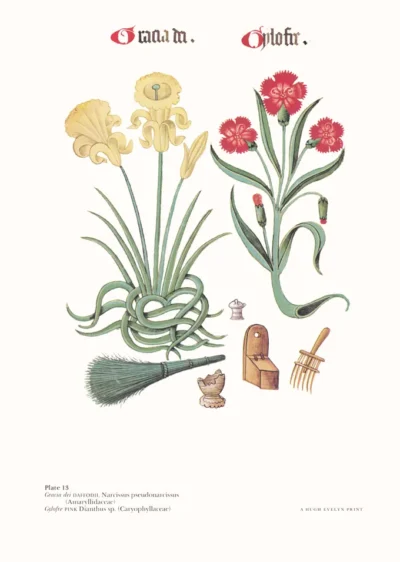Barberry & Broom
£20.00
Barberry and Broom (scroll down for a more detailed Description)
Published 1972 by © Hugh Evelyn Limited; drawn around 1525, these images were finished in gouache and watercolour (see description here)
Size: c. 23 x 33.5 cm [9 ″ x 13 ¼ ″] may vary slightly from printers’ cut 50 years ago
Printed on high white matt cardstock 144 g/sm2.
Print is STANDARD size – shipping is the same for 1 to 10 prints (based on largest print size in your order) – see Shipping & Returns.
In stock
Description
Barberry: Berberis, commonly known as barberry, is a genus of deciduous and evergreen shrubs from 1 – 5 m (3.3 – 16.4 ft) tall, found throughout temperate and subtropical regions of the world (apart from Australia). Early names for the strikingly handsome but distinctly prickly Barberry bush were berbarya and barboranne, which may derive from the Latin barbaris. It was formerly much planted for its bright orange-red fruits or berries, which contain malic acid, and can either be eaten raw, used to make jam or jelly, or candied. Many bushes may be survivors from mediaeval monasteries or nunneries. It is still planted as an ornamental shrub. It is a problem in agriculture since it is a host to a fungus causing black stem rust in wheat (the fungus alternates its life cycle between Barberry and wheat). The ‘Doctrine of Signatures’ (1) claims that as it has yellow bark, the Barberry could cure the ‘yellow disease’, from the so-called Jaundice Tree. The Barberry was considered a tonic, purgative and antiseptic, and was used for jaundice, liver complaints, general debility and biliousness. It is a pleasant acid drink made from the berries, said to be good for diarrhoea and fevers. Broom: All the brooms and their relatives (including Laburnum and Ulex) grow in Europe, north Africa and southwest Asia. The bright yellow flowers of Broom are a familiar sight It grows all over the British Isles on heath, wasteland and sandy soils. It shuns chalk. Its leaves somewhat reduced as it adapted to dry and windy habitats. The name Broom (from the Old English brōm) is common, found in place names like Bromley and Brompton. It was also the- a spray of which was the badge of Henry II, the Plantagenet. Nicholas Culpeper (2) records that it was ‘generally used by all good housewives almost throughout the land to sweep their houses with’. Although it was used by witches, it could also be used against them. The plant contains poisonous alkaloids but accidental poisoning is unlikely: 25 pounds of broom would be needed to kill a horse. Cystine, sparteine and scoparin occur in broom-tops. These were once described as a panacea for all female ailments, and for liver and kidney infections, still in use as a diuretic. There are illustrious precedents for this practice, since Gerard (3) records that Henry VIII ‘was wont to drinke the distilled water of Broome flours against surfets (i.e. over-eating) and diseases thereof arising.’
Additional information
| Weight | 0.0094 kg |
|---|---|
| Dimensions | 24 × 33.7 cm |





